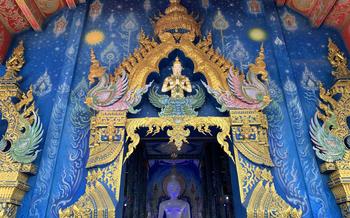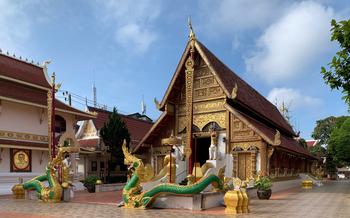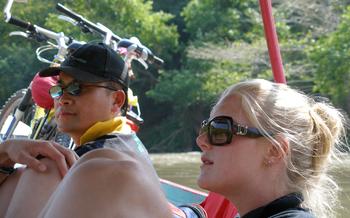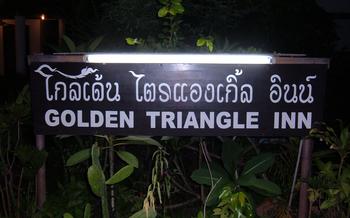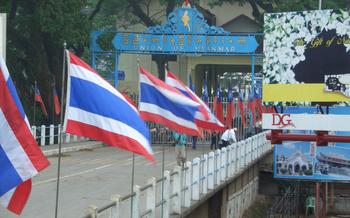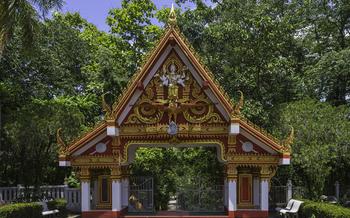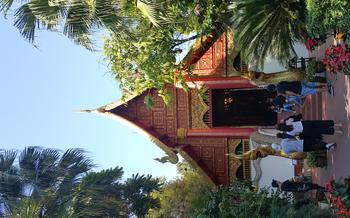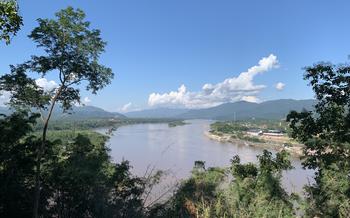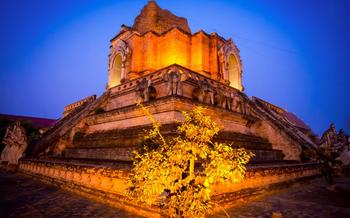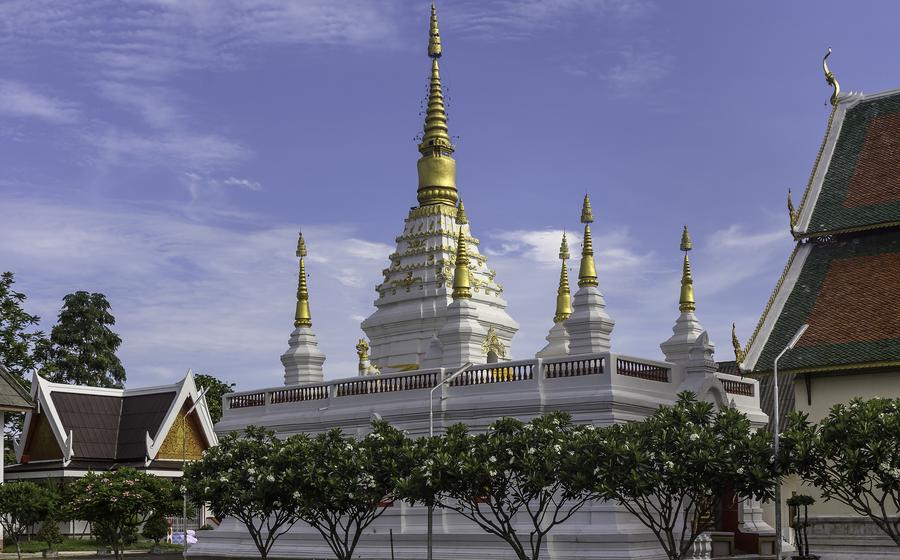
Wat Ming Muang
- Historical Background
- Main Attractions
- Unique Features
- Visitor Experience
- Opening Hours and Admission
- Guided Tours
- Photography Guidelines
- Nearby Attractions
- Getting There
- Location and Accessibility
- Public Transportation
- Rented Vehicles
- Accommodation Options
- Food and Dining
- Shopping and Souvenirs
- Festivals and Events
- Safety and Precautions
- Responsible Tourism
- Exploring Beyond the Temple
- Insider Tip: Unveiling the Hidden Gem of Wat Tham Pha Plong
Historical Background
Wat Ming Muang, a revered temple in Chiang Rai, Thailand, holds a significant place in the city's history and cultural heritage. Built in the 14th century by King Phayu, the temple has undergone several renovations over the years, preserving its architectural integrity while adapting to the changing times. The Lanna-style architecture, characterized by intricate carvings, stupas, and sweeping roofs, reflects the artistic and cultural influences of the ancient Lanna Kingdom, paying homage to the region's rich history and traditions.
Wat Ming Muang has served as a spiritual and cultural center for the local community since its inception. Devotees from all walks of life gather here to pray, make offerings, and seek blessings. The temple also hosts significant religious festivals and ceremonies, such as Songkran (Thai New Year) and Visakha Bucha (Buddha's Birthday), bringing together the community in celebration and fellowship.
Main Attractions
Wat Ming Muang is home to several remarkable attractions that draw visitors from around the world. The most prominent feature is the awe-inspiring Phra Ming Muang Buddha, a colossal bronze statue standing at an impressive 12 meters in height. This majestic Buddha image, crafted with exquisite artistry, exudes a sense of serenity and commands attention with its intricate details. It is considered one of the most revered and sacred Buddha statues in the region.
The temple walls are adorned with intricate murals and paintings that depict scenes from Buddhist mythology and Lanna history. These murals, created by skilled artisans, showcase the rich artistic heritage of the Lanna Kingdom. Each mural tells a story, providing visitors with a glimpse into the beliefs, customs, and traditions of the Lanna people.
In addition to the main Buddha image and murals, Wat Ming Muang houses a collection of Buddha statues, ancient artifacts, and religious relics. These artifacts offer a fascinating glimpse into the temple's history and the religious practices of the Lanna people. Visitors can explore the various Buddha statues, each with its own unique features and significance, and learn about their role in Lanna Buddhism.
Unique Features
Wat Ming Muang is renowned for its intriguing and unique features that set it apart from other temples in Chiang Rai. One of its most captivating attractions is the underground tunnel. This secret passageway leads to a hidden chamber beneath the temple, shrouded in mystery and intrigue. Legends abound about the tunnel's purpose, with some believing it was used by monks for meditation or as a secret escape route during times of conflict.
Another unique feature of Wat Ming Muang is the wishing well. Located within the temple grounds, this sacred well holds a special significance in Lanna beliefs. Devotees toss coins into the well, making wishes and seeking blessings from the temple's spirits. The well is believed to have the power to grant wishes and bring good fortune to those who make offerings with a pure heart.
Finally, the temple exudes a serene and spiritual atmosphere, conducive to meditation and reflection. Visitors are often drawn to the temple's tranquil ambiance, finding solace and inner peace within its sacred walls. The temple's serene surroundings, coupled with the intricate artwork and the presence of resident monks, create an environment that is ideal for spiritual contemplation and connection with the divine.
Visitor Experience
Opening Hours and Admission
Wat Ming Muang welcomes visitors from 8:00 AM to 5:00 PM daily. The temple does not charge an entrance fee, but donations are gratefully accepted to help maintain its upkeep and support the resident monks. It is important to dress respectfully when visiting the temple, with shoulders and knees covered. Visitors are also requested to remove their shoes before entering the main shrine room.
Guided Tours
For a deeper understanding of the temple's history and significance, visitors can hire local guides who are knowledgeable about the site. These guides can provide insights into the temple's architecture, murals, and religious practices. Guided tours typically last for around 30-60 minutes and can be arranged through the temple office or local tour operators.
Photography Guidelines
Photography is allowed within the temple grounds, but visitors are asked to be respectful of the sacred nature of the site. Avoid using flash photography inside the main shrine room, as this can be disruptive to worshippers and damage the delicate murals. It is also important to refrain from taking photos of monks without their permission.
Nearby Attractions
Wat Ming Muang is surrounded by a wealth of other captivating attractions that offer a deeper dive into Chiang Rai's rich cultural tapestry and natural beauty.
-
Wat Phra That Doi Chom Thong: Perched atop a hill, this neighboring temple commands breathtaking panoramic views of the surrounding landscape. Its gleaming white stupa, intricate murals, and historical significance make it a must-visit destination.
-
Chiang Rai Night Bazaar: Immerse yourself in the vibrant atmosphere of this bustling night market, where you can savor delectable street food, browse a myriad of souvenirs, and witness captivating cultural performances.
-
Clock Tower: Don't miss the iconic clock tower, a symbol of Chiang Rai. Witness its nightly light and sound show, a mesmerizing spectacle that illuminates the city's skyline with vibrant colors and enchanting melodies.
Getting There
Location and Accessibility
Wat Ming Muang is conveniently situated within the city limits of Chiang Rai, making it easily accessible for visitors. The temple is located along Prachasamran Road, just a short distance from the bustling city center. Its central location allows for easy navigation, whether you choose to walk, cycle, or take public transportation.
Public Transportation
Chiang Rai's public transportation system offers a convenient and affordable way to reach Wat Ming Muang. Several bus lines, including the red songthaews, pass by the temple, making it accessible from various parts of the city. Simply hop on a bus or songthaew and ask the driver to drop you off at Wat Ming Muang.
Rented Vehicles
For those who prefer the flexibility of exploring at their own pace, renting a vehicle is a great option. Motorbikes and cars are readily available for rent in Chiang Rai, providing you with the freedom to explore not only Wat Ming Muang but also the surrounding areas. Rental shops can be found throughout the city, offering a range of vehicles to suit your needs and budget.
Accommodation Options
Wat Ming Muang's proximity to the city center provides visitors with a range of convenient accommodation options. For those seeking a comfortable stay, several hotels and guesthouses are located within walking distance, offering a variety of amenities to suit different budgets and preferences.
Budget-conscious travelers can opt for cozy guesthouses that offer basic yet clean and comfortable rooms. These guesthouses often have a friendly and homely atmosphere, allowing guests to interact with fellow travelers and gain insights into local culture.
For a more immersive experience, visitors can consider staying in local homestays. This is an excellent opportunity to connect with local families, learn about their daily lives, and sample traditional Lanna cuisine. Homestays typically provide simple but comfortable accommodations and offer a unique glimpse into the region's rich cultural heritage.
For those seeking a truly unique accommodation experience, there are several charming options available near the temple. These include treehouses nestled amidst lush greenery, offering stunning views of the surrounding countryside, and riverside bungalows that provide a tranquil retreat along the banks of the Kok River.
Food and Dining
When visiting Wat Ming Muang, immersing yourself in the local culinary scene is a must. The temple's surroundings teem with eateries and street food stalls offering an array of delectable dishes that showcase the region's rich flavors.
For those seeking a taste of authentic Lanna cuisine, the khao soi, a flavorful noodle curry dish with crispy egg noodles, is a must-try. Other local delicacies include sai ua, a spicy northern Thai sausage, and gaeng hang lay, a pork belly curry.
Vegetarian travelers will find a welcoming haven in Chiang Rai, as many restaurants offer a variety of meatless options. From tofu curries and stir-fried vegetables to fresh fruit salads, there's something to satisfy every palate.
For a truly immersive culinary experience, venture into the vibrant street food scene near the temple. Here, you'll find an array of mouthwatering dishes, from grilled meats and seafood to sweet treats, all at affordable prices.
Don't forget to try the local fruits, such as the sweet and tangy mangoes and the aromatic durian, which is considered a delicacy in Southeast Asia.
To fully embrace the local culture, embrace the art of bargaining when shopping at markets. Remember to be polite and respectful, and don't be afraid to ask for a fair price.
Shopping and Souvenirs
Wat Ming Muang's vicinity offers an array of shopping opportunities for visitors seeking unique souvenirs and local handicrafts. Explore the vibrant markets and shops to discover intricately woven textiles, beautiful pottery, and exquisite silverwork that showcase the region's rich artistic heritage.
-
Local Handicrafts: Immerse yourself in the vibrant world of local handicrafts, where skilled artisans create exquisite woven textiles, pottery, and intricate silverwork. These handcrafted items reflect the unique traditions and creativity of the Lanna culture, making for meaningful souvenirs.
-
Souvenir Shops: Peruse the charming souvenir shops near the temple to find a treasure trove of unique gifts and mementos. From hand-painted postcards to intricately carved wooden figurines, these shops offer a diverse selection of items that capture the essence of Chiang Rai.
-
Bargaining Tips: Embrace the local custom of bargaining when shopping in markets. Approach vendors with a friendly smile, show genuine interest in their products, and negotiate politely. Remember, bargaining is a respectful and enjoyable cultural exchange in Thailand.
Festivals and Events
Wat Ming Muang is not just a place of worship but also a vibrant center for cultural and community events. The annual temple fair, held during Songkran (Thai New Year), is a highlight for both locals and visitors. The temple grounds transform into a bustling marketplace, with colorful stalls selling traditional Lanna handicrafts, delicious street food, and souvenirs. Visitors can immerse themselves in the festivities, enjoying cultural performances, parades, and water-throwing activities that symbolize cleansing and renewal.
Throughout the year, Wat Ming Muang also hosts various Lanna cultural events and festivals that showcase the region's rich traditions and heritage. These events often feature traditional music and dance performances, elaborate processions, and ceremonies that honor local beliefs and customs. Visitors are welcome to participate in these events, gaining a deeper understanding of Lanna culture and its vibrant expressions.
Safety and Precautions
Visiting Wat Ming Muang is generally safe, but it's essential to take precautions to ensure a smooth and enjoyable experience. Be aware of your surroundings and belongings, especially in crowded areas, to avoid pickpocketing or scams. Respect local customs and dress modestly to show respect for the temple's sacred nature.
The temple has implemented security measures, including CCTV surveillance and security guards, to ensure the safety of visitors and their belongings. In case of an emergency, contact details for local authorities, hospitals, and tourist assistance are available at the temple office.
To ensure the safety of the temple and its visitors, avoid climbing on or touching the Buddha statues or religious artifacts. Refrain from loud noises or disruptive behavior that may disturb the peaceful atmosphere of the temple. Smoking and alcohol consumption are prohibited within the temple grounds.
Responsible Tourism
As a responsible traveler, it is essential to respect the local environment and contribute positively to the community when visiting Wat Ming Muang and the surrounding area. Here are a few tips for practicing responsible tourism:
-
Respect the Environment: Minimize your ecological footprint by reducing waste, conserving water and energy, and avoiding activities that could harm the temple's natural surroundings. Dispose of trash properly in designated bins and refrain from littering.
-
Support Local Communities: Support the local economy by patronizing locally-owned businesses, such as souvenir shops, restaurants, and homestays. This helps to create jobs and preserve traditional livelihoods.
-
Volunteer Opportunities: Consider volunteering your time and skills to give back to the local community. There may be opportunities to teach English, assist with conservation efforts, or participate in community development projects.
Exploring Beyond the Temple
While Wat Ming Muang is a must-visit destination in Chiang Rai, there's so much more to explore in the region. For those with limited time, consider taking a day trip to nearby attractions. One popular option is visiting the hill tribe villages in the surrounding mountains. Here, you can learn about the unique cultures and traditions of the various ethnic groups that call this region home. Take a guided tour to gain insights into their way of life, visit their colorful markets, and witness traditional performances.
For those with more time, consider embarking on a multi-day itinerary to explore the broader Chiang Rai province. Start by visiting the stunning Wat Rong Khun (White Temple), known for its intricate white architecture and unique artwork. Then, head to the Golden Triangle, where the borders of Thailand, Myanmar, and Laos meet. Here, you can visit the Hall of Opium Museum to learn about the history of opium cultivation in the region.
If you're looking for a more adventurous experience, consider exploring the national parks and natural wonders of Chiang Rai. Visit the Tham Luang Cave, where a dramatic rescue operation took place in 2018, saving a group of trapped soccer players and their coach. You can also hike to the top of Phu Chi Fa, the highest peak in the province, and marvel at the stunning views of the surrounding countryside.
No matter how you choose to explore beyond Wat Ming Muang, make sure to allow ample time to soak in the rich culture, natural beauty, and unique experiences that Chiang Rai has to offer.
Insider Tip: Unveiling the Hidden Gem of Wat Tham Pha Plong
Beyond the bustling crowds of Wat Ming Muang, discover a hidden gem nestled amidst the tranquil hills of Chiang Rai - Wat Tham Pha Plong. This secluded temple boasts a breathtaking cave sanctuary adorned with intricate Buddha images, stalactites, and stalagmites that create an ethereal atmosphere. As you venture deeper into the cave, you'll encounter a serene meditation chamber where you can find solace and connect with your inner self. While Wat Tham Pha Plong may be off the beaten path, it offers a unique and profound experience that will leave you feeling rejuvenated and spiritually enriched.
